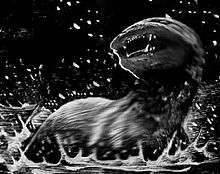Dobhar-chú
 Artist's impression | |
| Grouping | Legendary creature |
|---|---|
| Sub grouping | Lake and river |
| Other name(s) | King Otter |
| Country | Ireland |
| Habitat | Water |
The Dobhar-chú (Irish pronunciation: [ˈd̪ˠaɾˠxuː], lit. "water dog" or "water hound") or King Otter is a creature of Irish folklore. It resembles both a dog and an otter though sometimes is described as a half dog, half fish. It lives in water and has fur with protective properties.[1]
Description
A headstone, found in Conwall cemetery in Glenade, County Leitrim depicts the Dobhar-chú and is related to a tale of an attack on a local woman by the creature. The stone is claimed to be the headstone of a grave of a woman killed by the Dobhar-chú in the 17th century. Her name was supposedly Gráinne. Her husband supposedly heard her scream as she was washing clothes down at Glenade Lough and came to her aid. When he got there she was already dead, with the Dobhar-chú upon her bloody and mutilated body. The man killed the Dobhar-chú, stabbing it in the heart. As it died, it made a whistling noise, and its mate arose from the lough. Its mate chased the man but, after a long and bloody battle, he killed it as well.
Note that dobharchú is an obsolete Irish word for 'otter'. The modern Irish word for water is 'uisce' although 'dobhar' is also (rarely) used. 'Dobhar' is a much older form and cognates are found in other Celtic languages (e.g. Welsh, 'dwr', water). 'Cú' is 'hound' in Irish (see, for example, 'Cúchulainn', the hound of Culainn).The Dobhar-chú is also known as the "dobarcu", and anglicised as "doyarchu" and "dhuragoo".
See also
References
- ↑ Shuker, Karl (12 June 2014). "1: The Dobhar-chú - Ireland's Mysterious Master Otter". The Beasts That Hide from Man: Seeking the World's Last Undiscovered Animals. Cosimo, Inc. pp. 11–22. ISBN 978-1-61640-621-9.